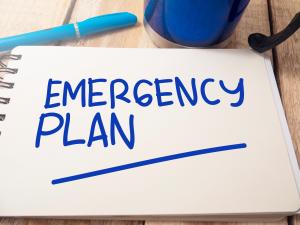
Importance of Emergency Preparedness Plans for Households
Understanding the Need for Emergency Preparedness
Severe weather events, hurricanes, floods, and other emergencies can cause power outages, road closures, and disruptions to essential services. "Without a preparedness plan, families may struggle to respond effectively, leading to unnecessary risks," notes Carr Jr.
An emergency plan outlines necessary steps to take before, during, and after an event. This includes securing supplies, identifying evacuation routes, establishing communication methods, and ensuring that each household member understands their role in an emergency. Advanced planning reduces confusion and helps individuals respond with greater confidence under stressful conditions.
Key Elements of an Emergency Preparedness Plan
A comprehensive emergency plan addresses various aspects of safety and survival. Several key components ensure that households are prepared for different scenarios:
Risk Assessment: Identifying potential hazards in a specific area, such as hurricanes, tornadoes, flooding, or power outages, helps determine the appropriate response measures.
Evacuation Routes: Knowing multiple evacuation routes ensures that individuals can leave safely if necessary. Road closures and changing conditions should be considered when planning.
Communication Plan: Establishing methods for staying in contact with family members and emergency responders is essential. Cell phone networks may be overloaded or unavailable, making backup communication options important.
Emergency Contacts: Maintaining a list of emergency contacts, including local authorities, medical facilities, and neighbors, provides quick access to assistance.
Shelter and Safety Measures: Whether sheltering in place or evacuating, identifying safe locations is critical. Storm shelters, reinforced interior rooms, or designated evacuation centers should be included in the plan.
First Aid and Medical Needs: Ensuring access to first aid supplies, prescription medications, and essential medical equipment prepares households to address injuries or medical conditions.
Utility Shut-Off Procedures: Knowing how to turn off gas, water, and electricity helps prevent additional hazards during emergencies.
Importance of Emergency Supply Kits
An emergency supply kit ensures that necessary items are readily available when an emergency occurs. A well-stocked kit includes:
Food and Water: At least three days’ worth of non-perishable food and one gallon of water per person per day.
First Aid Supplies: Bandages, antiseptics, pain relievers, and any required prescription medications.
Flashlights and Batteries: Reliable lighting sources in case of power outages.
Battery-Powered Radio: Access to weather alerts and emergency broadcasts.
Clothing and Blankets: Protection from extreme temperatures and unexpected conditions.
Personal Documents: Copies of identification, insurance policies, and emergency contacts in a waterproof container.
Regularly checking and updating emergency kits ensures that supplies remain effective and unexpired.
Training and Preparedness Drills
Regular emergency drills and preparedness exercises improve response times and ensure that household members understand their roles. Practicing evacuation procedures, reviewing communication plans, and testing emergency equipment provide confidence in handling real-life situations.
Families with young children, elderly members, or individuals with special needs should tailor drills to accommodate specific challenges. Assigning responsibilities ensures that each person knows what to do in different emergency scenarios.
Community Coordination and Support
Emergency preparedness extends beyond individual households. Neighborhoods and communities that coordinate efforts strengthen overall resilience. Establishing local support networks, sharing resources, and participating in community response programs improve outcomes during disasters.
Local government agencies and emergency management teams provide valuable resources and guidance for preparedness planning. Accessing local emergency alerts, participating in disaster response training, and staying informed about community resources enhance preparedness efforts.
Challenges and Overcoming Common Barriers
Many individuals delay emergency planning due to a lack of awareness, time, or perceived necessity. However, waiting until an emergency occurs increases risks and limits available options. Common barriers to preparedness include:
Underestimating Risk: Believing that disasters will not affect a specific area or household leads to inadequate preparation.
Lack of Resources: Some families may struggle to afford emergency supplies, making it essential to seek community programs or assistance.
Uncertainty About Steps to Take: Clear guidance and planning templates help households create effective plans without confusion.
Overcoming these challenges requires education, community outreach, and access to resources that simplify the preparedness process.
Long-Term Benefits of Preparedness
Households that invest in emergency preparedness experience several long-term benefits:
Faster Recovery: Having a plan in place reduces downtime and accelerates the ability to return to normal activities after a disaster.
Reduced Stress: Knowing what steps to take in an emergency reduces panic and uncertainty.
Greater Safety: Preparedness measures help protect lives, prevent injuries, and minimize property damage.
Conclusion
Establishing an emergency preparedness plan is essential for ensuring safety, minimizing disruption, and improving recovery efforts in the face of disasters. Advanced planning helps individuals and families navigate unexpected events with greater confidence and efficiency. By taking proactive steps to assess risks, gather supplies, and coordinate response efforts, households contribute to stronger, more resilient communities.
Morgan Thomas
Rhino Digital, LLC
+1 504-875-5036
email us here
Visit us on social media:
Facebook
Distribution channels: Building & Construction Industry, Culture, Society & Lifestyle, Environment, Natural Disasters, Real Estate & Property Management
Legal Disclaimer:
EIN Presswire provides this news content "as is" without warranty of any kind. We do not accept any responsibility or liability for the accuracy, content, images, videos, licenses, completeness, legality, or reliability of the information contained in this article. If you have any complaints or copyright issues related to this article, kindly contact the author above.
Submit your press release

